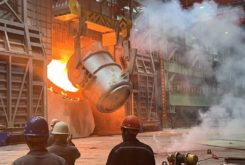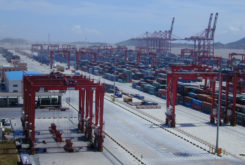While new coal and LNG port terminals in the northern half of Mozambique attract most international attention, the port of Maputo continues to grow rapidly. The more northerly projects are designed to handle domestic exports but, in contrast, Maputo has managed to regain its historic role as an important entrepôt for South African trade.
Mozambique’s most important container port received US$800 million in investment between 2003 and 2016, while the state owned transport utility, Portos e Caminhos de Ferro de Moçambique (CFM), is investing US$200 million in new port and rail projects over the period 2018-20, its biggest capital commitment to date. The record level of investment has been enabled by rising profits, which mean that the company now values its assets at more than US$1 billion for the first time.
The port of Maputo is operated by Maputo Port Development Company (MPDC), which is owned by Grindrod (24.7%), DP World (24.7%), CFM (49%) and another local firm, Mozambique Gestores (1.6%). MPDC’s concession has been extended to 2033 with an option for another ten years, in order to give the investors more confidence that they will be able to recoup additional investment. DP World, which is based in the United Arab Emirates, is one of the biggest container port operators in the world, while Grindrod is a South African logistics firm with interests across Southern Africa.
Maputo has benefitted from substantial dredging work over the past few years, including work on the access channel by Jan de Nul Dredging Middle East in 2016 that was completed at a cost of US$85 million. The minimum depth of the access channel was increased from less than 11 metres to 14.3 metres, allowing access for post-Panamax vessels as a result. Higher cargo volumes have been enabled by efficiency measures as well as infrastructural investment. MPDC has introduced a Fixed Berthing Window, under which vessels are required to dock and leave at specific times, in order to reduce waiting times.
The next phase of port improvements that is already underway will provide access for even larger vessels to encourage shipping lines to include Maputo on their intercontinental services, including between China and the African continent, rather than merely on feeder services. Work on extending berths 6, 7, 8 and 9 and deepening them to at least 15 metres is scheduled for completion by January 2020. Existing warehouse capacity is being upgraded and new capacity built, while the car terminal is being expanded.
Two new mobile harbour cranes were delivered to the port in February under a US$19 million contract. The chief operating officer of Porto de Maputo, Marla Calado, said: “Our turnaround times have been improving (and are often faster than in the region). We believe this new equipment will enable us to further increase our operational efficiency, our competitiveness and our volumes in terms of cargo handling.”
Calado added: “In addition to the two mobile harbour cranes, we have recently acquired 14 payloaders, 8 tractors, 8 forklifts and 2 rail excavators (for wagon unloading operations).” Turnaround times are the period it takes to process a vessel and unload and load cargo before it can leave its berth.
Higher cargo volumes
The port improvements have already begun to feed through into higher cargo volumes. Maputo set an annual cargo handling record in 2018, four years after its last record. It handled 19.5 million tonnes in combined import and export cargo last year, up 7.14% on the figure for 2017, so MPDC is well on the way to meeting its target of handling 30 million tonnes/year by 2033.
Maputo container terminal’s handling capacity has been increased from 150,000 TEU/year to 250,000 TEU/year and MPDC hopes to boost capacity to 450,000 TEU/year in the second phase of expansion. A TEU, or twenty foot equivalent unit, is the industry standard container size.
The transport sector as a whole is beginning to meet the government directive to move more cargo by rail. The proportion of cargo arriving at the port by rail rather than road increased from 18% in 2016 to 26% in 2018. It is in the best interests of the government to support the port, as it is one of its main sources of revenue. MPDC alone paid more than US$90 million in taxes and dividends to the government in 2017.
Maputo and other ports in Mozambique are now benefitting from the installation of container scanners. Containers previously had to be inspected in order to ascertain that their actual contents corresponded to the contents stated in their documentation. Container scanners can undertake this work much more quickly and also help to identify contraband hidden inside licit cargo.
For instance, in April 2018, a scanner detected “a huge amount” of ivory that had been hidden in polypropylene in containers passing through the port. Illegal hardwood timber consignments have also been detected. In some instances, gangs use hidden compartments inside containers to avoid physical detection but scanners can detect these. In addition, it became compulsory for containers to be weighed in 2016 and for the method of weighing to be declared from last year.
Matola Coal Terminal
Aside from containers, the port’s most important cargo is coal and Matola Coal Terminal (MCT) is being expanded in phases by operator Grindrod. Unlike the existing and planned coal terminals further north in Mozambique, MCT handles only South African coal.
It shipped a record 5.3 million tonnes/year in 2017, with most of the coal shipped to Asian customers, and the terminal loaded a monthly record 580, 214 tonnes of coal in December. The quay has been redeveloped to serve vessels up to 275 metres in length and can now accommodate vessels of up to 15.5 metres draught at high tide and 14.5 metres at low tide.
Matola is being positioned as a viable alternative to Richards Bay Coal Terminal, which lies down the coast in South Africa’s KwaZulu-Natal Province and which is the biggest single coal terminal in the Southern Hemisphere. Matola currently handles coal mined in Mpumalanga Province but is even more handily placed to receive coal from the Waterberg Basin in the far north of South Africa, which is being developed to replace maturing fields in Mpumalanga.
CFM has relaunched its own coal rail services from South Africa to Matola along the Ressano Garcia railway, 20 years after they ended because of the lack of locomotives and wagons. This had left all coal rail services to the terminal operated by South Africa’s Transnet Freight Rail. CFM spokesperson Adélio Dias has said that the number of coal trains travelling in each direction will now increase from four to seven, boosting transport capacity on the line to 7.65 million tonnes/year, in line with Matola’s coal capacity.
Two new bridges are being built on the line and 24km of the route upgraded to support the new capacity. As a result of line improvements and cooperation between the various parties involved, longer trains with 50 wagons are being used to transport coal to the terminal. The first 80 wagon train was tested in September 2018.
The South African angle
Coal aside, a number of other South African firms are switching – or plan to switch – business from the port of Durban to Maputo. BMW South Africa exports most of the 3 Series cars it produces at its Rosslyn plant in South Africa and has transferred a lot of its business from Durban to Maputo since 2013.
At the same time, the outgoing chief executive of fruit producer Capespan, Dawie Ferreira, said in March that his firm was in talks with Maputo over shipping more of its production out of the Mozambican port. Capespan has already signed an agreement with various Chinese trade bodies to promote reefer exports of South African produce to China. Reefer is the industry term for refrigerated cargo.
Freight volumes have also benefitted from a cooperation agreement between CFM and Transnet Freight Rail. The volume of ferro-chrome and chromium exported from the port increased by almost 100% in 2017 and by another 53% last year, with much of it bound for China.
In addition, Maputo is handling a small but increasing proportion of Chinese exports to South Africa, although it is difficult to find accurate figures. This role is likely to increase with improvements to the N4 highway from Johannesburg to the Port of Maputo. In particular, access to the port has been greatly improved by the completion of the delayed 3km Maputo-Catembe Bridge, which is the longest suspension bridge in Africa.
The US$785 million project provides access across Maputo Bay, where trucks previously had to make a one hour ferry journey or a three hour detour around the bay. In addition, a new 120km stretch of road is being built from Catembe to the South African border, providing direct access to the port. The current bridge toll is almost US$3. At the bridge opening ceremony, President Filipe Nyusi said of the 141 metre high structure: “With the completion of this bridge… the connection of Southern Africa to the north over land and across our country is guaranteed.” (CLBrief)



